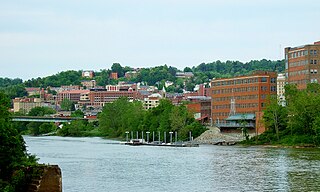
Morgantown is the county seat of Monongalia County, West Virginia, United States, situated along the Monongahela River. West Virginia University is in the city. The population was 30,712 at the 2020 Census Bureau, making Morgantown the largest city in North-Central West Virginia. The Morgantown metropolitan area has a population of 138,176.

The Harner Homestead, is a historic home outside Morgantown, Monongalia County, West Virginia.
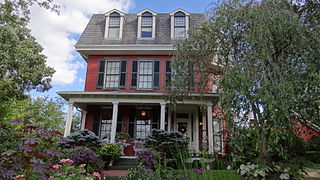
The Alexander Wade House is a historic house at 256 Prairie Street in Morgantown, West Virginia. Built in 1860, it was the home of educator Alexander Wade (1832-1904) from 1872 until his death. Wade is credited with developing a system of grade promotional exams and graduations that was widely adopted in the late 19th century. The house was declared a U.S. National Historic Landmark in 1965.

Walters House, also as known as the Walters Residence, is a historic home located in Morgantown, Monongalia County, West Virginia. It was built about 1900–1901, and is a brick Queen Anne style brick dwelling. It features a three-story tower in the southeast corner topped with a wrought-iron balustrade. The architect is unknown. It was a single family home until 1931, after which it was a boarding house, fraternity house, home of the University Christian Council, and law offices. It is currently the location of the Morgantown Chabad Jewish Center. It was listed on the National Register of Historic Places in 1983. It is located in the Downtown Morgantown Historic District, listed in 1996.

Harmony Grove Meeting House, also known as Harmony Grove Church, is a historic church off I-79 in Harmony Grove, Monongalia County, West Virginia. It was built in 1854, and is a small, one-story wood-frame building. It measures 20 feet wide and 50 feet long. It sits on a foundation of rough-cut stone blocks. It is the oldest unaltered church building in Monongalia County.

Women's Christian Temperance Union Community Building, also known as the WCTU Building, is a historic building at 160 Fayette Street in Morgantown, Monongalia County, West Virginia. It was built in 1922 by the Woman's Christian Temperance Union, and is a detached, brick, four-story plus basement structure in the Classical Revival style. It features a smooth-cut stone cornice topped by a balustrade. The interior has a two-level basement that houses a large gymnasium. The building also houses office space, meeting rooms, private apartments, and recreational facilities.

Adam Stephen House is a historic home located at Martinsburg, Berkeley County, West Virginia. It was built between 1772 and 1789, and is a 2+1⁄2-story, stone house measuring 43 feet, 5 inches, by 36 feet, 3 inches. It was the home of Adam Stephen. Built of shaped limestone, it stands on a prominent stone ledge, with two outbuildings in stone and log. After falling into near-ruin, iIt was restored in the 1960s by the General Adam Stephen Memorial Association and is open as a historic house museum. The house was built over a natural cave, with stone steps leading down from the basement. A local caver's organization has worked since 2002 to excavate the cave, which had become plugged with earth, and the excavation is available for tours on open house days.
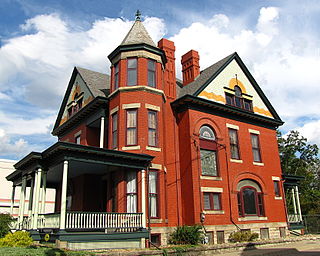
Judge Frank Cox House is a historic home located at Morgantown, Monongalia County, West Virginia. It was designed by Morgantown architect Elmer F. Jacobs and built in 1898. It is a 2+1⁄2-story Queen Anne style brick dwelling. It features a three-story tower, ornate wood porches, stained glass windows and elaborate interior woodwork. It was the home of Judge Frank Cox, a prominent lawyer who served as prosecuting attorney and Judge on the Supreme Court of Appeals of West Virginia.

Rogers House is a historic home located at Morgantown, Monongalia County, West Virginia. It was originally built about 1857 and is one of the last remaining residences from this time period in downtown Morgantown. The building is a two-story, five bay brick and wood frame dwelling in the Classical Revival style. The original section of the house is in brick, whereas the addition, designed by noted Morgantown architect Elmer F. Jacobs and built in 1905-1906 is wood frame. Jacobs is also responsible for the interior design. It sits on a rough-faced coursed ashlar stone foundation. It features a front porch with four sets of triple wooden, Tuscan order columns. It was the home of the Rogers family, pioneer settlers of Morgantown. It has been the home of West Virginia University's Campus Ministry Center since 1984. It was listed on the National Register of Historic Places in 1984. It is located in the Downtown Morgantown Historic District, listed in 1996.

Ford House is a historic home located at Morgantown, Monongalia County, West Virginia. It was built about 1868, and is a 1+1⁄2-story, "L" shaped Gothic Revival style cottage. It features a steeply pitched gable roof, a Gothic arched window in the center gable, and lattice work in lieu of bargeboard on the front porch.

Hackney House, also known as Hackney Place, is a historic home located at Morgantown, Monongalia County, West Virginia. The original section was built in 1892, and is a square, 2+1⁄2-story balloon frame structure with a Queen Anne style entrance porch. A two-story, square addition was added shortly after the original construction. It sits on a cut sandstone foundation.

Waitman T. Willey House is a historic home located at Morgantown, Monongalia County, West Virginia. It was built in 1839–1840, and is a 1+1⁄2-story, "L"-shaped brick residence in the Classical Revival style. The front facade features a one-story pentastyle portico with five fluted wood Doric order columns and a high pitched triangular pediment. It was built for Waitman T. Willey (1811-1900), noted lawyer, orator, and statesman.

Vance Farmhouse, also known as Meeks Farmhouse, Dean's House, and Bicentennial House, is a historic home located on a West Virginia University farm at Morgantown, Monongalia County, West Virginia. The original section was built about 1854, and is a two-story, I house form brick dwelling. The 1+1⁄2-story rear addition was built before 1900, and the two-story side addition on the northeast elevation was added in the 1930s. It features a wrap-around porch added sometime before 1900. The property was acquired for the West Virginia University Experiment Station in 1899. It housed the dean of the College of Agriculture from 1915 to 1957. During the United States Bicentennial in 1976, it was used as a showcase for exhibits on Monongalia County history. It has housed the West Virginia University Institute for the History of Technology and Industrial Archeology and is currently home to West Virginia University Press.
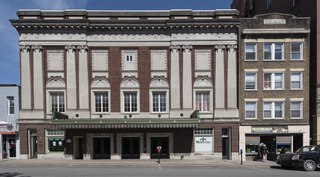
Metropolitan Theatre is a historic theater building located at Morgantown, Monongalia County, West Virginia. It opened July 24, 1924, two-and-a-half years after construction began, and consists of a single floor auditorium with balcony. The building measures 72 feet by 143 feet, and has two storefronts on the ground floor and a pool room in the basement. The front facade features fluted concrete Ionic order pilasters with egg-and-dart detail in the Classical Revival style. The theater continues to provide a home for the city's best live entertainment.

Monongalia County Courthouse is a historic courthouse building located in Morgantown, Monongalia County, West Virginia. The courthouse was erected in 1784 with the current structure built in 1891. This Romanesque style building consists of a two-story building with a basement, five-story clock tower and a three-story South tower. The building measures at 99’ by 83’ by 99’ by 76’ with the first story at fifteen feet high and the second story at twenty-two feet high. The distinctive central clock tower has a pyramidal roof, four doomed buttresses, stone molds over the four clocks and tower windows, arcade belfry, and quatrefoil design with the building date. The original northern facade was covered by an addition built in 1925 with another addition built in 1975. Connected to the courthouse is a two-story Italianate style jailhouse built in 1881.

D.I.B. Anderson Farm, also known as the D.I.B. Anderson House and Chauncey M. Price House, is a historic home located in Morgantown, Monongalia County, West Virginia. It was built about 1866, and is a two-story, asymmetrical brick farmhouse in a vernacular Italianate style. It features a one-story front porch and a second story "sleeping porch." Also on the property is a contributing ice house and summer kitchen building built of hand made bricks, and a cut sandstone well house.

Cooper's Rock State Forest Superintendent's House and Garage is a historic home and garage located at Cooper's Rock State Forest near Morgantown, Monongalia County, West Virginia. The house was built between 1938 and 1940, and is a two-story, symmetrical log building, measuring 35 feet by 43 feet. Also on the property is a contributing garage also of log construction. Both buildings were built by the Civilian Conservation Corps, CCC camp number 3527, Camp Rhododendron.
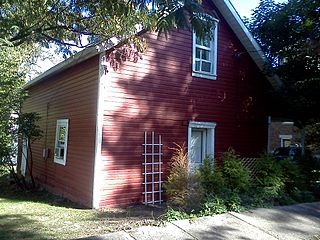
Kern's Fort, also known as Michael Kern's Cabin, is a historic home located at Morgantown, Monongalia County, West Virginia. It is a one-story log house built in 1772. It is built of chestnut logs and covered with wood clapboards. Attached to the rear is a 19th-century frame addition. It was built by Michael Kern, perhaps, the first permanent settler of what is now Morgantown. When Lord Dunmore's War started in 1774, Kern built a stockaded fort around his cabin.

Seneca Glass Company Building, now called Seneca Center, is a historic glass factory located at Morgantown, Monongalia County, West Virginia. It was built by the Seneca Glass Company in 1896–1897, and is an industrial complex of work areas, all connected by doors, passageways, or bridges. A fire in 1902, destroyed much of the interior of the original brick part of the complex. After the fire, Elmer F. Jacobs designed the new two-story replacement, a new Needle Etching Room in a separate building connected by a bridge, and the reconstruction of the Grinding, Glazing, and Cutting areas. A large addition was built in 1947. The building features a conical brick stack that projects 36 feet above the roofline of the Furnace / Blowing Room. The complex was the home of one of the finest hand-blown, hand-cut and etched, lead glass factories in the world. After the factory closed in 1983, it was adapted for commercial use.

The Downtown Morgantown Historic District is a federally designated historic district in Morgantown, Monongalia County, West Virginia. The district, encompassing approximately 75 acres, has 122 contributing buildings and 2 contributing sites including commercial and public buildings, residences, and churches. The district has been listed on the National Register of Historic Places since May 2, 1996. Ten of the contributing buildings are listed separately on the National Register of Historic Places. Significant structures located within the historic district are the Monongalia County Courthouse, the Metropolitan Theater, and the Old Morgantown Post Office.























